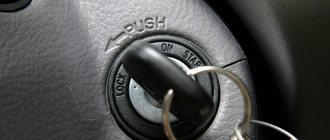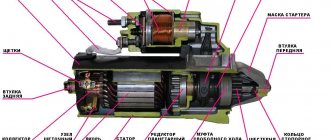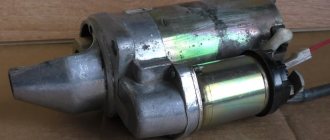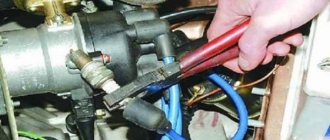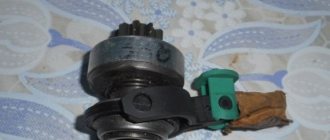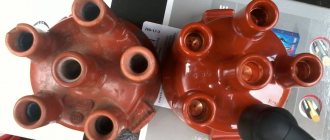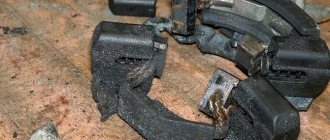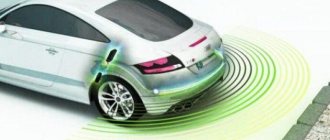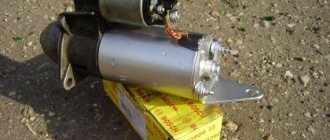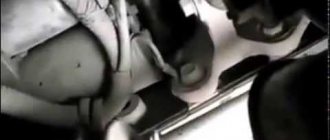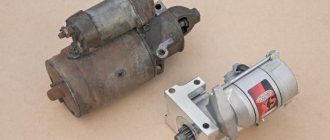Some men can find problems and malfunctions with their own hands, repair and replace the necessary parts. This article with instructions will be useful for those who are ready to repair their car themselves. And for those who value their time and want to save money, we recommend turning to professionals. Our company works seven days a week, and our prices will please you. We offer starter armature testing services in Minsk efficiently and quickly at any time. We have modern equipment installed, with the help of which our professionals will quickly and accurately identify the problems and malfunctions of your car. We work with almost all brands of cars such as: BMW, Toyota, Mitsubishi, Audi, Volksvagen, Mazda, Nissan, Opel and many others.
Starter diagnostics and testing
If you find yourself on a highway far from a service center, you should know how to remove the starter and diagnose problems yourself. Diagnostics can be carried out visually and using a multimeter. A visual inspection will help you identify any chips or cracks – they need to be repaired. Next you need to check the starter armature.
We will tell you how to ring the starter armature with a multimeter in this article. If you do not have the opportunity to ring it yourself, we will help you check the starter armature with a multimeter.
Starter repair begins with disassembling the electric motor armature. The causes of the malfunction may be:
- Loss of contacts at the terminals.
- Wear and breakage of brushes.
- High temperatures for commutator plates.
- Poor insulation.
- Short circuit between plates.
- Interturn closure.
- Anchor jamming in the snout.
The first signs of a starter malfunction:
- characteristic hum sound;
- vibration during starter operation;
- the appearance of sparks;
- strong heating of the case and the appearance of an unpleasant smell of burnt plastic;
- change in armature rotation.
Other possible faults
Using a multimeter, you have determined the integrity of the coils and power contacts. All circuits are fine, but the solenoid relay still doesn't work. This means there are other reasons for the part to fail. The last electrical damage that the multimeter has not tested is turn-to-turn short circuits in the coils. And this damage cannot be repaired; you will have to buy a new part.
Mechanical deformations are determined only when opening the part itself. But not all structures can be disassembled; most often they have to be replaced as an assembly.
This video clearly shows how to properly test the solenoid relay with a multimeter. You will see everything that was said in this article in this video:
How to diagnose the problem and repair the starter
If you were unable to visually determine the place where the wiring was broken, you can short it with a wire at the junction of all the lamellas and apply voltage. In the place where it burns out there is a breakdown. You also need to pay attention to the condition of the lamellas. If they are damaged and repair is possible, then the lamellas must be restored.
The starter rotor winding is also checked with a light bulb. We apply the lamp starter to the collector plate and see whether the lamp lights up or not. If it lights up, it is necessary to replace the winding or completely replace the rotor. If it does not light up, check the resistance with an ohmmeter. The resistance should be small, approximately 10 kOhm.
If there is an interturn short circuit, a device for checking the starter armature will help determine it. The solution to the problem is to correct and align all the wires and clear them of debris.
If the above methods do not help, rewinding the anchor will help you.
To repair the anchor yourself, start by removing the short circuit; be sure to clean the location of the short circuit and check whether it appears again.
When unsoldering the collector terminals, we remove the rotor and thoroughly clean the surfaces using a drill, solder them and check for interturn short circuits.
To determine a burnt anchor, you need to use a battery.
How to properly remove from the starter
To check the solenoid relay with a multimeter, you need to remove it from the starter and be sure to mark the location of the armature relative to the housing. This is important because in some cases the bendix attachment point has an unusual shape. If you turn it the other way during assembly, problems may arise in its operation.
You can tap the heads of the screws with a hammer if you cannot budge them. When unscrewing the screws with a screwdriver, remember safety. Never hold the part with your left hand in line with the direction of the screwdriver. Otherwise, when you remove the screwdriver from the screw, with all the effort of your right hand, you will plunge a sharp metal sting into your left hand.
It is not difficult to use a multimeter; there is no particular danger in the device. Switch the device to the “dialing” mode. We check each winding separately.
Starter diagnostic frequency
Depending on the load on the starter, its wear will depend; accordingly, the greater the load, the more often the starter needs to be diagnosed. Do not forget to diagnose and repair vehicle problems in a timely manner.
Now you know step by step how to check the starter at home. You can order diagnostics and repair of your car starter from our company Modnikov. Good luck on the roads!
Diagnostics and repair of the starter armature in a garage
Starter
is a unit that no vehicle can do without, since this element is one of the main ones in the ignition system.
As is clear, there are no endless parts and at times the starter unit tends to fail. How to check and repair the battery in the key in a Toyota Corolla Verso. If you decide to replace the battery in the key of a Toyota Corolla Verso with your own hands, then it is better to do everything in one of these. more about what malfunctions are typical for this element and how to check the
car starter armature on your own at home from this material.
How to check the starter armature for MFZ and other faults
An integral part of any car is the starting device. If it functions well, then starting the engine will not cause problems, even in winter. On the contrary, if there are flaws in the starter, it will be more and more difficult to start the engine each time. From this article you will learn how to check the starter armature at home for interturn short circuits and other faults.
Possible armature malfunctions
Malfunctions associated with the starter unit, in one way or another, affect the entire ignition system. How to remove the headlight on a Volkswagen Touareg 1 at home, how to remove the tail light of a Lada Kalina station wagon?. You will immediately know about the failure of the unit, since it is impossible to start the engine without it.
The main faults corresponding to this device:
See:
- collector wear, which may be uneven;
- short circuit between the turns of the windings of the unit;
- an insulation breakdown to ground has occurred;
- collector contacts are unsoldered;
- The studded elements under the bushings are worn out.
So that you can solve problems of this kind on your own, it will be useful for you to know how to check the armature
starter. We will tell you more about diagnostics and repair below.
Checking the starter unit with a tester
Basic faults
Let's look at the main faults of the starter armature:
- Insulation breakdown to ground;
- Short circuit between turns;
- Wear of studs for bushings;
- Uneven wear of the collector;
- Wiring of collector terminals.
These malfunctions provoke failure of the car's starter, and, accordingly, the ignition system. As a rule, these breakdowns are not solved in an instant, but require some time and effort. Malfunctions can be solved with the help of specialists or on your own, but to carry out this work you need to stock up on the necessary tools and some equipment.
Anchor repair
One of the most common problems in the operation of the starter armature is a short circuit.
, namely, we are talking about windings located on the housing. In order to solve this problem, it will be necessary to carry out a visual diagnosis of the outputs of the unit, as well as the wiring of the element. By doing this, you can find the place where the breakdown occurred. After it is found, you need to clean the contacts and diagnose the resistance; for this, a multimeter is used. The video will talk about how to replace the silent block of a crab on front-wheel drive VAZ cars at home using improvised means. After that, you should insulate the broken area, why you can use super glue with asbestos.
If a visual inspection does not allow you to find the location of the breakdown, another method can be used for diagnosis. To test the generator at home, you will need a multimeter. You can independently check the belt tension, charging relay, diode bridge, stator, bearings and brushes. It consists of connecting all the lamellas of the device together, but for this you need to use a special stripped wire. When the lamellas are closed, it will be necessary to apply voltage to the device (to the commutator and ground), and since it must be very high, this may require a welding machine. How to charge a gel scooter battery at home. In fact, this is precisely where the complexity of the method lies. The place where there is a breakdown will burn out (video author - Konstantin Petrakov).
How to repair a VAZ-2107 starter with your own hands
To repair the starting unit yourself, you must:
- remove and disassemble the device;
- check the condition of the windings, bushings and brushes;
- replace damaged elements;
- perform reassembly and check the correctness of the electrical wiring connections.
Dismantling and disassembly
To remove and disassemble the unit you must:
- Disconnect the terminals from the battery, and then remove the battery from the engine compartment.
- Remove the protective shield under the power unit, which limits access to the electric motor.
- Unscrew the nuts holding the wires to the starter housing.
- Using a wrench, unscrew the bolts connecting the electric motor housing to the power unit crankcase.
- Pull the assembly out of the seat.
- Unscrew the solenoid relay nut and remove the assembly from the electric motor housing.
- Unscrew the tightening bolts and carefully remove the covers, and then remove the rotor from the stator.
Replacing bushings
Replacement of starter bushings is carried out when the gap between the shaft and the support is increased. Due to a violation of the relative position of the parts, the rotor touches the stator plates. To eliminate the defect, it is necessary to remove worn parts.
The damaged front support is knocked out of the mounting hole with a handy tool, the rear blind bushing is removed with a puller or drilled out on a machine.
To install new elements (made of bronze or composite material), mandrels made of soft material (for example, wood) are used. During installation, do not warp parts or use excessive force.
Before installation, the composite bushings are kept for 5-10 minutes in a container with motor oil, which saturates the porous surface. Bronze bearings are lubricated when installing the rotor shaft.
Replacing electric brushes
To supply voltage to the rotor windings, a flat commutator and brushes (made of a mixture of graphite and copper powder), pressed by springs, are used. The number of brushes corresponds to the number of poles; the design of the elements includes an elastic stranded wire. During operation, the graphite elements wear out and burn, and at the same time, wear appears on the collector.
Replacement of graphite brushes is carried out according to the following algorithm:
- Remove the back cover of the case.
- Unscrew the screws securing the brushes (there are 4 elements in total).
- Remove worn elements and install new brushes.
- Clean the stator cavity from residual wear products of graphite elements.
- Install the removed parts in their original places.
Repair of starter retractor relay
The electromagnetic retractor relay ensures the movement of the gear on the rotor, which engages with the flywheel ring gear when the electric starter is connected to the vehicle's on-board network. The device is located on the body of the starting unit; the design of the circuit includes an additional power relay (located under the hood).
If the unit breaks down, it is necessary to check the functionality of the control relay. It is recommended to tighten the fastening screw and make sure that there are no oxides on the contact plates and wiring.
To test the relay, you must close the starter directly. If the rotor rotates, the electromagnetic unit must be replaced. Additional diagnostics involves measuring the voltage of the windings with a test device.
Checking the starter armature.
Anchor check
for interturn short circuit. The video shows how to repair a headlight hydraulic booster in the field. Let’s make a reservation right away: our device is homemade, since in Russia it’s similar.
In the event that an interturn short circuit occurs in the operation of the unit, such a problem can be determined using a special device. That’s what it’s called - PPYA - a device for checking the anchor. As practice shows, short circuits are often caused by the use of bent or crumpled wires or the presence of conductive particles between them. Don't know how to check the starter armature at home? Nothing could be simpler. Use a tester or other testing equipment. If this is the case, then it is necessary to correct all the problems (align the wires and clean them of debris), and then apply a layer of varnish on top, this will protect the device. If this method does not help you find the problem, you can rewind the armature yourself.
As for a short circuit, it usually affects the functioning of the collector. How to charge a gel battery for a scooter and at home, both inside. Subsequently, this can lead to burnout of the plates, as a result of which this element can completely collapse. If you have to solder, remember that before soldering the working surfaces must be thoroughly cleaned; you can use a drill for this. Using this device, you can perform a good cleaning of contacts, as well as lead wires. I’ll show you how to replace a car CV joint yourself at home. Starter conditions and how to check the armature at home" how. I'm not a master, but I hope my video will help someone. checked using an armature diagnostic device
.
Starter VAZ-2107
The commutator-type electric motor used to start the engine is located on the side of the crankcase of the power unit. The parts are connected to each other by bolts with a hexagonal head. Power is supplied from the battery.
The power of the device is sufficient to rotate the crankshaft at air temperatures down to -35 ° C (without preheating the oil). The appearance and design of the device are shown in the photo in the spare parts catalogues.
Purpose
The device is designed to force the engine crankshaft at startup. The product is equipped with a special Bendix clutch, which engages with a ring gear mounted on the flywheel of the power plant. The electric motor is controlled remotely using a contact group in the ignition switch through an additional relay.
Starter electrical connection diagram
There are 2 types of electric motors for starting the power plant:
- On cars with a carburetor, a standard starter is used; torque is transmitted directly from the rotor to the ring gear.
- On some carburetor cars and VAZ-2107 with an injector, a gear-type drive was installed. By using a planetary gear, the current in the power circuit is reduced and the torque is increased.
Why do you need a starter and its design features?
A starter (from the English word start - to begin) is a mandatory unit for starting the engine, which forcibly rotates the crankshaft flywheel to the speed necessary for independent operation.
It is a 4-pole DC electric motor that takes energy from a battery. The starter is necessary to start the engine of any vehicle and receives power from the battery when the key is turned in the ignition.
Main components of the starter:
- housing - a cylinder-shaped steel part in which the winding and cores are located;
- anchor - has the shape of an axis and is made of high-strength steel, collector plates and windings are fixed in it;
- a solenoid relay that supplies power to the starter when the key is turned in the ignition and pushes out the bendix;
- brushes and brush holders - supply the necessary voltage to the armature commutator unit, increasing the motor power when the engine spins up;
- drive gear and bendix (overrunning clutch).
Despite the huge range of electric motors, there are only two types, distinguished by the presence of a gearbox.
The most modern version of an electromagnetic motor is a gear motor , the main advantages of which include the ability to operate even with a low battery charge and the presence of permanent magnets that reduce problems with the winding.
The main disadvantages of such a unit are the low strength of the gear and the impossibility of repair, which leads to an expensive purchase in the event of a breakdown.
Starters that do not contain a gearbox in their design directly act on the rotating gear.
The main advantages of this type of starter are:
- simultaneous engagement of the flywheel with the gear, allowing you to start the internal combustion engine as quickly as possible;
- durability and long-term operation;
- the ability to independently repair breakdowns and the availability of necessary spare parts in almost any auto shop;
- practically independent of the influence of electric current, which reduces the possibility of breakdowns.
The disadvantages of gearless starters include:
- difficulty starting in extreme cold;
- significant mass of the unit;
- high energy consumption, leading in some cases (if there are faults in the starting system or other components) to a strong discharge of the battery and the impossibility of starting the internal combustion engine without recharging;
- quite high prices for spare parts.
Starter relay malfunction
If the relay malfunctions, there is only one problem: the engine does not start or does not start the first time. But there can be a lot of problems directly with the element itself. It is worth noting that the starter must be diagnosed and checked every time you contact a service station for the purpose of maintenance. In this case, you will be able to prevent possible future malfunctions and replace elements that have lost their working life. The main relay failures include:
- Mechanical damage to the relay housing.
- Burning of contacts.
- Broken electrical wiring.
- Technical fluids entering the relay.
- After starting the power unit, the starter continues to rotate (a characteristic buzzing sound can be heard).
- Short circuit in the windings.
- The return spring is deformed or weakened.
- Souring of the core inside the housing.
Main signs of starter malfunction
Despite the fact that the starter is a fairly reliable device, it can also break. Some breakdowns may have symptoms identical to other faults, but there is still something in common when the electric motor malfunctions.
The main symptoms of starter malfunctions:
The solenoid relay does not click (does not operate) and the armature does not rotate.
- Battery discharge (complete or partial) or failure;
- Oxidation of battery terminals and tips connected to it;
- The terminals or tips connected to both the starter itself and the battery have come loose;
- Lack of contact on the terminal bolts, caused by a break in the wires connecting the ignition switch and starter;
- Short circuit, break or breakdown of the solenoid relay windings to ground.
When the electric motor starts and the solenoid relay is operational, the armature rotates slowly or does not rotate at all.
- The contact on the terminal bolts of the solenoid relay is broken;
- High wear of brushes or their jamming;
- Burning or overheating of the collector plates;
- Breakdown of the stator winding caused by insulation failure or interturn short circuit;
- Damage to the insulating layer of the positive brush holder;
- Short circuit of collector plates caused by insulation failure;
The armature of a running starter rotates, but the crankshaft does not spin.
- Overrunning clutch slipping;
- Mechanical damage to the freewheel (buffer spring, underwater ring);
- The starter drive fork is flying out or damaged;
- Difficulty in moving the drive along the thread on the anchor shaft.
After starting the engine, the starter continues to operate.
- Drive fork jamming;
- Damage to the ignition switch spring;
- Jamming of the solenoid relay or starter drive contacts on the anchor shaft;
- Damage or stretching of the springs that return the solenoid relay or overrunning clutch;
- Solenoid relay jammed;
- Warping of the electromagnetic motor caused by unscrewing its fastenings to the internal combustion engine.
What does it mean about a malfunction?
The main signs indicating a breakdown of the solenoid relay include the following:
- There is no starter shutdown after the engine starts. It rotates at high speed, accompanied by a buzzing sound.
- The starter turns idle after turning the ignition key. In this case, there is no impact on the engine flywheel.
- A short click appears after an attempt to start the engine. This indicates that the device is triggered, but as a result the starter does not begin to rotate. In some situations, even a click is not observed due to armature sticking, a break in the coil, or lack of power.
Let's start checking with the simplest thing - with the relay.
Checking the starter using the battery
Before contacting a car service center, buying a new unit or spare parts for it, you should try to check its performance yourself. With the right approach, it is possible to independently identify problems.
First of all, if you suspect a malfunction of the starting device, you need to check the contacts on the battery and starter terminals, their tightness and the presence of oxidation, the battery charge, since in many cases the problem in starting the internal combustion engine is the above factors.
A simple way to check that the electrical network is working is to close the terminal bolts of the electric motor with a screwdriver; before this procedure, you need to put the car in neutral speed (or move the selector lever to park or neutral mode).
If the starter starts the engine, you should look for a fault in the electrical circuit. Otherwise, remove the unit by disconnecting all fasteners from the engine and removing terminals and other wires.
How to check Bendix
After removing the electric motor, it is necessary to inspect the bendix (the gear at the very end); if there is increased wear of the teeth or cracks in it, it should be replaced.
The Bendix should only turn in one direction, otherwise it will have to be replaced. By connecting the unit to the battery, it is unlikely to be able to diagnose the serviceability of the Bendix, since it can spin, but with insufficient force to start the internal combustion engine.
How to check Solenoid relay
When you turn the ignition key, you should hear a click, indicating that the armature is retracted and the bendix is engaged.
Before checking the serviceability of the starter, it is necessary to firmly secure it (either in a vice, having previously wrapped it with a thick layer of fabric, or with the help of a strong assistant who will hold the unit), since a very strong jerk may occur when starting it.
It is necessary to connect the positive from the battery to the positive on the starter, and the negative from the battery to the body of the unit. If the unit is working properly, then there should be a quick and sharp click and the bendix will extend and begin to spin.
If there is no click or movement of the overrunning clutch, it is necessary to replace the solenoid relay. When the power from the battery is disconnected, the bendix should retract.
How to check the Anchor and Brushes
To check the brushes and armature, you will need a multimeter or a 12-volt light bulb. Checking with a light bulb involves connecting its contacts to ground and the brush holder with the starter connected to the battery. When the light comes on, it indicates high brush wear.
When checking with a multimeter, the contacts are connected identically, only the results of measuring the resistance should tend to infinity, otherwise there is a short to ground.
The armature can only be checked by disassembling the electric motor. In addition to carrying out a visual inspection for the presence of oxidation, traces of short circuits, and increased wear, to check the armature you will need a special device PPYA (armature testing device) to check the interturn closure.
The difficulty of diagnosing armature malfunctions, as well as its repair, will require contacting specialized specialists, but in order to avoid unnecessary costs, it is necessary to check all other parts of the unit.
How to check the starter winding
To check the motor winding you will need a multimeter or a light bulb. The wires of the control lamp are connected to the winding terminal and the starter housing. If the light comes on, then there is a breakdown in the winding.
Using the same connection, the winding resistance is checked, for which the multimeter must be switched to the appropriate mode. The average reading of a serviceable winding will be 10 kOhm.
The starter is the most important element of the car, and its malfunction will immediately make itself felt either by the inability to start the car or by difficulties with it.
This unit is very reliable, but problems do occur with it. Some of them are easy to determine on your own, but to identify others you will need special equipment, which is available only to highly specialized specialists.
Checking the starter: how to check the functionality of the starter
So, if malfunctions are noticed in the operation of the starter, it is necessary to check and troubleshoot. In this case, it often becomes necessary to do a quick check of the starter without removing it.
To perform this test, the battery must be charged, and you must also have a pair of power wires on hand. Please note that the battery cannot test the armature, starter winding or brushes. To check these elements, the starter must be disassembled and then tested with a multimeter (tester). The available methods will be discussed below.
Checking the battery starter
When it comes to checking a battery starter, this method allows you to quickly check the functionality and efficiency of the device. The fact is that if you simply try to start the engine in the usual way, the starter may click, but nothing else happens.
To check how the starter extends the gear and turns, you need to connect the negative terminal to the housing, and apply the positive terminal to the upper terminal of the relay and switching contact.
If the gear does not extend, there may be several reasons:
- the retractor contacts are burnt;
- anchor jammed;
- The starter winding or relay is burnt out.
Normally, the bendix should move out with a characteristic click, after which the gear begins to turn by the starter motor. This method allows you to check the solenoid relay, while checking the solenoid relay from the battery is quite reliable.
Checking the starter brushes
The fastest way to check brushes is with a 12-volt test light. One terminal of the lamp is connected to the brush holder, while the other is connected to the housing. If the lamp starts to burn, the brushes need to be changed, since the protection is broken.
You can also check the brushes with a tester - a multimeter. To do this, the starter needs to be disassembled. The main goal is to check for a short to ground. Normally, the brushes should not short-circuit.
For example, if the bushings are worn out, then during start-up the voltage drops, the starter motor malfunctions, and the burnt-out commutator actually eats away the brushes. If the bushings are severely broken, this leads to distortions of the armature, the brushes wear unevenly, and the winding may short-circuit.
Bendix check
To check the starter bendix, the overrunning clutch housing is clamped in a vice. To avoid damage, you can put rubber gaskets on the “lips” of the vice. Next, an attempt is made to rotate the bendix in different directions. Please note that it should not rotate in both directions.
Checking the starter winding
To understand how to check the starter winding, it is important to know that such a check can be performed using a flaw detector or a 220 V light bulb. The method is similar to how brushes are checked. To check, a light bulb with a power of up to 100 Watts must be connected in series with a wire between the winding and the housing.
If it is necessary to check the starter rotor winding, you must perform similar actions. One lead of the test lamp is applied to the collector plate, and the other is thrown onto the core. If the lamp is on, this indicates the need to rewind the winding. The problem can also be solved by completely replacing the rotor.
Checking the starter armature
During the diagnostic process, it is important to know how to check the starter armature. To do this, you will need to directly supply 12 volts from the battery to the starter. In other words, voltage is bypassed into the relay.
If the starter turns, this means that the armature is in perfect order. If there is no rotation, then both the armature and the brushes may be problematic. In such a situation, the starter needs to be disassembled, then troubleshooted and checked with a multimeter, switching the device to ohmmeter mode to measure resistance.
As a rule, the list of problems with the armature includes possible breakdowns of the winding on the housing, the collector terminals are soldered, or an interturn short circuit of the winding has occurred. By the way, the last malfunction is usually detected with a special device (PPD).
Also, wear of the commutator, especially if it is uneven, causes wear of the brushes and failure of the starter. One of the reasons when the insulation protrudes between the lamellas is as a result of the commutator being displaced relative to the shaft axis. Please note that the total depth between the grooves of the armature commutator should not be less than 0.5 mm.
